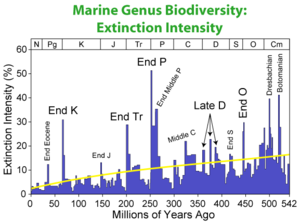Wymieranie triasowe
| Ten artykuł od 2011-01 wymaga zweryfikowania podanych informacji. |
Wymieranie późnotriasowe – masowe wymieranie około 201 milionów lat temu[1], w wyniku którego zniknęło około 80% gatunków morskich (zwłaszcza mięczaki, ramienionogi, fauna rafowa, amonity-ceratyty, konodonty) oraz wiele gatunków lądowych, m.in. większość przedstawicieli kladu Crurotarsi (aetozaury, fitozaury, rauizuchy). Spośród fauny lądowej przetrwały krokodylomorfy, dinozaury, ssaki, pterozaury i żółwie[2].
Wymieranie związane było najprawdopodobniej z wielkim załamaniem klimatycznym (efekt cieplarniany wywołany wulkanizmem), rozwój warunków beztlenowych.
Zobacz też
← mln lat temu Wymieranie triasowe | ||||||||||||
| ←4,6 mld | 541 | 485 | 443 | 419 | 359 | 299 | 252 | 201 | 145 | 66 | 23 | 2 |
Przypisy
- ↑ pap.pl: Erupcje wulkaniczne związane z wymieraniem sprzed 200 mln lat. [dostęp 2013-03-23].
- ↑ Michael J. Benton: Origin and Relationships of Dinosauria. W: David B. Weishampel, Peter Dodson, Halszka Osmólska: The Dinosauria (2nd edition). Berkeley: University of California Press, 2004, s. 7–19. ISBN 0-520-24209-2.
Media użyte na tej stronie
(c) Dragons flight, CC-BY-SA-3.0
This figure shows the en:genus en:extinction intensity, i.e. the fraction of genera that are present in each interval of time but do not exist in the following interval. The data itself is taken from Rohde & Muller (2005, Supplementary Material), and are based on the Sepkoski's Compendium of Marine Fossil Animal Genera (2002). The yellow line is a cubic polynomial to show the long-term trend. Note that these data do not represent all genera that have ever lived, but rather only a selection of marine genera whose qualities are such that they are easily preserved as fossils.
The "Big Five" en:mass extinctions (Raup & Sepkoski 1982) are labeled in large font, and a variety of other features are labeled in smaller font. The two extinction events occurring in the Cambrian (i.e. en:Dresbachian and en:Botomian) are very large in percentage magnitude, but are not well known because of the relative scarcity of en:fossil producing life at that time (i.e. they are small in absolute numbers of known en:taxa). The en:Middle Permian extinction is now argued by many to constitute a distinct extinction horizon, though the actual extinction amounts are sometimes lumped together with the End Permian extinctions in reporting. As indicated, the "Late Devonian" extinction is actually resolvable into at least three distinct events spread over a period of ~40 million years. As these data are derived at the genus level, one can anticipate that the number of en:species extinctions is a higher percentage than shown here.
Many of the extinction events appear to be somewhat extended in time. In at least some cases this is the result of a paleontological artifact known as the en:Signor-Lipps effect (Signor & Lipps 1982). Briefly, this is the observation that inadequate sampling can cause a taxon to seem to disappear before its actual time of extinction. This has the effect of making an extinction event appear extended even if it occurred quite rapidly. Hence, when estimating the true magnitude of an extinction event it would be common to combine together the events occurring over several preceding bins as long as they also show excess extinctions. This explains why many estimates of the magnitude of an extinction event may be larger than the 20-30% shown as the largest single bin for most of the extinctions shown here.
en:Image:Phanerozoic Biodiversity.png shows total en:Phanerozoic en:biodiversity during the same interval. Note that this is a result of changes in both the rate of extinctions and the rate of new originations. The Dresbachian extinction event in particular is obscured by nearly immediate replacement with new genera.]]
